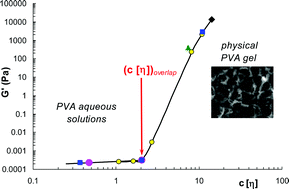In situgelation of aqueous solutions of entangled poly(vinyl alcohol)
Abstract
Rheological behaviour of poly(vinyl alcohol) (PVA) aqueous systems was systematically investigated at 30 °C for different concentrations, molecular weights and

Maintenance work is planned for Wednesday 1st May 2024 from 9:00am to 11:00am (BST).
During this time, the performance of our website may be affected - searches may run slowly and some pages may be temporarily unavailable. If this happens, please try refreshing your web browser or try waiting two to three minutes before trying again.
We apologise for any inconvenience this might cause and thank you for your patience.
* Corresponding authors
a
“Petru Poni” Institute of Macromolecular Chemistry, 41-A Grigore Ghica Voda Alley, 700487 Iasi, Romania
E-mail:
bercea@icmpp.ro
Fax: +40 232 211299
Tel: +40 232 217454
b University Lille Nord de France, Lille, France
c Ecole des Mines de Douai, Department of Polymers and Composites Technology & Mechanical Engineering, 941 Rue Charles Bourseul, B.P. 10838, Douai, France
Rheological behaviour of poly(vinyl alcohol) (PVA) aqueous systems was systematically investigated at 30 °C for different concentrations, molecular weights and

 Please wait while we load your content...
Something went wrong. Try again?
Please wait while we load your content...
Something went wrong. Try again?
M. Bercea, S. Morariu and D. Rusu, Soft Matter, 2013, 9, 1244 DOI: 10.1039/C2SM26094H
To request permission to reproduce material from this article, please go to the Copyright Clearance Center request page.
If you are an author contributing to an RSC publication, you do not need to request permission provided correct acknowledgement is given.
If you are the author of this article, you do not need to request permission to reproduce figures and diagrams provided correct acknowledgement is given. If you want to reproduce the whole article in a third-party publication (excluding your thesis/dissertation for which permission is not required) please go to the Copyright Clearance Center request page.
Read more about how to correctly acknowledge RSC content.
 Fetching data from CrossRef.
Fetching data from CrossRef.
This may take some time to load.
Loading related content
